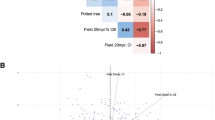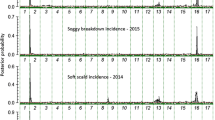Abstract
Bitter pit is one of the most economically important physiological disorders affecting apple fruit production, causing soft discrete pitting of the cortical flesh of the apple fruits which renders them unmarketable. The disorder is heritable; however, the environment and cultural practices play a major role in expression of symptoms. Bitter pit has been shown to be controllable to a certain extent using calcium sprays and dips; however, their use does not entirely prevent the incidence of the disorder. Previously, bitter pit has been shown to be controlled by two dominant genes, and markers on linkage group 16 of the apple genome were identified that were significantly associated with the expression of bitter pit symptoms in a genome-wide association study. In this investigation, we identified a major QTL for bitter pit defined by two microsatellite (SSR) markers. The association of the SSRs with the bitter pit locus, and their ability to predict severe symptom expression, was confirmed through screening of individuals with stable phenotypic expression from an additional mapping progeny. The data generated in this current study suggest a two gene model could account for the control of bitter pit symptom expression; however, only one of the loci was detectable, most likely due to dominance of alleles carried by both parents of the mapping progeny used. The SSR markers identified are cost-effective, robust and multi-allelic and thus should prove useful for the identification of seedlings with resistance to bitter pit using marker-assisted selection in apple breeding programs.




Similar content being viewed by others
References
Allen GJ, Chu SP, Harrington CL et al (2001) A defined range of guard cell calcium oscillation parameters encodes stomatal movements. Nature 411:1053–1057
Amarante CVT, Chaves DV, Ernani PR (2006) Mineral composition and bitter pit severity in ‘Catarina’ apples. Rev Bras Frutic 28:51–54
Amarante CVT, Miqueloto A, Steffens CA, Santos A, Argenta LC (2013) Changes in xylem functionality during apple fruit development: implications on calcium concentration and incidence of bitter pit. Acta Hortic 1012:135–140
Amtmann A, Blatt MR (2009) Regulation of macronutrient transport. New Phytol 181:35–52
Blatt MR (2004) Membrane transport in plants. Blackwell Publishing, Oxford
Chagne D, Crowhurst RN, Troggio M et al (2012) Genome-wide SNP detection, validation, and development of an 8K SNP array for apple. PLoS One 7:12
Chen DH, Ronald PC (1999) A rapid DNA minipreparation method suitable for AFLP and other PCR applications. Plant Mol Biol Rep 17:53–57
Delong WA (1936) Variations in the chief ash constituents of apples affected with blotchy cork. Plant Physiol 11:453–456
DeLong JM, Prange RK, Harrison PA (2004) The influence of pre-storage delayed cooling on quality and disorder incidence in ‘Honeycrisp’ apple fruit. Postharvest Biol Technol 33:175–180
Evans K (2013) Apple breeding in the Pacific Northwest. Acta Hortic 976:75–78
Fallahi E, Conway WS, Hickey KD, Sams CE (1997) The role of calcium and nitrogen in postharvest quality and disease resistance of apples. HortScience 32:831–835
Faust M, Shear CB (1968) Corking disorders of apples: a physiological and biochemical review. Bot Rev 34:441–469
Ferguson IB, Watkins CB (1989) Bitter pit in apple fruit. Hortic Rev 11:289–355
Fernandez-Fernandez F, Evans KM, Clarke JB, Govan CL, James CM, Maric S, Tobutt KR (2008) Development of an STS map of an interspecific progeny of Malus. Tree Genet Genomes 4:469–479
Fernandez-Fernandez F, Antanaviciute L, Govan CL, Sargent DJ (2011) Development of a multiplexed microsatellite set for fingerprinting red raspberry (Rubus idaeus) germplasm and its transferability to other Rubus species. J Berry Res 1:177–187
Fernandez-Fernandez F, Antanaviciute L, van Dyk MM, Tobutt KR, Evans KM, Rees DJG, Dunwell JM, Sargent DJ (2012) A genetic linkage map of an apple rootstock progeny anchored to the Malus genome sequence. Tree Genet Genomes 8:991–1002
Greene DW (1991) Reduced rates and multiple sprays of paclobutrazol control growth and improve fruit quality of delicious apples. J Am Soc Hortic Sci 116:807–812
Hamilton DWA, Hills A, Kohler B, Blatt MR (2000) Ca2+ channels at the plasma membrane of stomatal guard cells are activated by hyperpolarization and abscisic acid. Proc Natl Acad Sci USA 97:4967–4972
Hewett EW, Watkins CB (1991) Bitter pit control by sprays and vacuum infiltration of calcium in ‘Cox’s Orange Pippin’ apples. HortScience 26:284–286
Korban SS, Swiader JM (1984) Genetic and nutritional status in bitter pit-resistant and pit-susceptible apple seedlings. J Am Soc Hortic Sci 109:428–432
Kumar S, Garrick DJ, Bink M, Whitworth C, Chagne D, Volz RK (2013) Novel genomic approaches unravel genetic architecture of complex traits in apple. BMC Genomics 14:13
Lewis TL (1980) Rate of uptake and longitudinal distribution of potassium, calcium and magnesium in the flesh of developing apple fruits of 9 cultivars. J Hortic Sci 55:57–63
Lotze E, Theron KI (2006) Dynamics of calcium uptake with pre-harvest sprays to reduce bitter pit in ‘Golden Delicious’. Acta Hortic 721:313–319
Lotze E, Joubert J, Theron KI (2008) Evaluating pre-harvest foliar calcium applications to increase fruit calcium and reduce bitter pit in ‘Golden Delicious’ apples. Sci Hortic 116:299–304
Maliepaard C, Alston FH, van Arkel G et al (1998) Aligning male and female linkage maps of apple (Malus pumila Mill.) using multi-allelic markers. Theor Appl Genet 97:60–73
Miqueloto A, do Amarante CVT, Steffens CA, dos Santos A, Mitcham E (2014) Relationship between xylem functionality, calcium content and the incidence of bitter pit in apple fruit. Sci Hortic 165:319–323
Padmarasu S, Sargent DJ, Jaensch M, Kellerhals M, Tartarini S, Velasco R, Troggio M, Patocchi A (2014) Fine-mapping of the apple scab resistance locus Rvi12 (Vb) derived from ‘Hansen’s baccata #2’. Mol Breed 34:2119–2129. doi:10.1007/s11032-014-0167-3
Pavicic N, Jemric T, Kurtanjek Z, Cosic T, Pavlovic I, Blaskovic D (2004) Relationship between water-soluble Ca and other elements and bitter pit occurrence in ‘Idared’ apples: a multivariate approach. Ann Appl Biol 145:193–196
Perring MA, Pearson K (1986) Incidence of bitter pit in relation to the calcium content of apples—calcium distribution in the fruit. J Sci Food Agric 37:709–718
Pesis E, Ebeler SE, de Freitas ST, Padda M, Mitcham EJ (2010) Short anaerobiosis period prior to cold storage alleviates bitter pit and superficial scald in Granny Smith apples. J Sci Food Agric 90:2114–2123
Rafalski A (2002) Applications of single nucleotide polymorphisms in crop genetics. Curr Opin Plant Biol 5:94–100
Sargent DJ, Passey T, Surbanovski N, Girona EL, Kuchta P, Davik J, Harrison R, Passey A, Whitehouse AB, Simpson DW (2012) A microsatellite linkage map for the cultivated strawberry (Fragaria × ananassa) suggests extensive regions of homozygosity in the genome that may have resulted from breeding and selection. Theor Appl Genet 124:1229–1240
Schlotterer C (2000) Evolutionary dynamics of microsatellite DNA. Chromosoma 109:365–371
Silfverberg-Dilworth E, Matasci CL, Van de Weg WE, Van Kaauwen MPW, Walser M, Kodde LP, Soglio V, Gianfranceschi L, Durel CE, Costa F, Yamamoto T, Koller B, Gessler C, Patocchi A (2006) Microsatellite markers spanning the apple (Malus × domestica Borkh.) genome. Tree Genet Genomes 2:202–224
Smock RM, Neubert AM (1950) Apples and apple products. Interscience Pub, New York
Toth G, Gaspari Z, Jurka J (2000) Microsatellites in different eukaryotic genomes: survey and analysis. Genome Res 10:967–981
Van Ooijen JW (2006) JoinMap® 4, software for the calculation of genetic linkage maps in experimental populations. Kyazma B.V., Wageningen
Van Ooijen JW (2009) MapQTL® 6, software for the mapping of quantitative trait loci in experimental populations of diploid species. Kyazma B.V., Wageningen
Velasco R, Zharkikh A, Affourtit J et al (2010) The genome of the domesticated apple (Malus × domestica Borkh.). Nat Genet 42:833–841
Volz RK, Alspach PA, Fletcher DJ, Ferguson IB (2006) Genetic variation in bitter pit and fruit calcium concentrations within a diverse apple germplasm collection. Euphytica 149:1–10
Voorrips RE (2002) MapChart: software for the graphical presentation of linkage maps and QTLs. J Hered 93:77–78
Xu K, Wang A, Brown S (2012) Genetic characterization of the Ma locus with pH and titratable acidity in apple. Mol Breed 30:899–912
Yuri JA, Retamales JB, Moggia C, Vasquez JL (2002) Bitter pit control in apples cv. Braeburn through foliar sprays of different calcium sources. Acta Hortic 594:453–460
Zupan A, Mikulic-Petkovsek M, Cunja V, Stampar F, Veberic R (2013) Comparison of phenolic composition of healthy apple tissues and tissues affected by bitter pit. J Agric Food Chem 61:12066–12071
Acknowledgments
This work was supported by a grant from the Autonomous Province of Trento to the Fondazione Edmund Mach, Trentino, Italy.
Author information
Authors and Affiliations
Corresponding author
Electronic supplementary material
Below is the link to the electronic supplementary material.
11032_2015_258_MOESM1_ESM.tif
Supplementary Fig. 1 – Initial linkage map and QTL analysis using interval mapping for 94 individuals of R × X mapping population. Marker positions are given in cM, and accompanying graphs give LOD scores associated with bitter pit symptom expression.(TIFF 960 kb)
11032_2015_258_MOESM2_ESM.tif
Supplementary Fig. 2 – Schematic representation of the segregation of alleles within the R × X progeny and their associated expected phenotypes, according to the two gene model for bitter pit susceptibility of Korban and Swiader (1984). (TIFF 59 kb)
11032_2015_258_MOESM3_ESM.pdf
Supplementary Table 1 – Results of mapping and QTL analysis using interval mapping on a subset (n = 94) of the R × X mapping population that displayed a consistent phenotype across all three years of evaluation. The position of each of the nine markers across the linkage group is given, along with the LOD score and associated percentage variance explained for each marker. (PDF 14 kb)
11032_2015_258_MOESM4_ESM.pdf
Supplementary Table 2 – Results of mapping and QTL analysis using interval mapping the full mapping progeny of n = 364 individuals of the R × X mapping population across all three years of evaluation. The position of each marker across the linkage group is given, along with the LOD score and associated percentage variance explained for each of the four markers scored. (PDF 14 kb)
11032_2015_258_MOESM5_ESM.pdf
Supplementary Table 3 – Validation of alleles in coupling with severe bitter pit symptom expression in nine susceptible (phenotype 4) and seven resistant (phenotype 0) plants belonging to B × C progeny that gave a consistent phenotype over two years evaluation. (PDF 12 kb)
Rights and permissions
About this article
Cite this article
Buti, M., Poles, L., Caset, D. et al. Identification and validation of a QTL influencing bitter pit symptoms in apple (Malus × domestica). Mol Breeding 35, 29 (2015). https://doi.org/10.1007/s11032-015-0258-9
Received:
Accepted:
Published:
DOI: https://doi.org/10.1007/s11032-015-0258-9




